3 Volumes
Philadelphia Since the Industrial Revolution
The Industrial Revolution began about the time America declared Independence. The young nation faced a clean slate and boundless opportunities.
Sociology: Philadelphia and the Quaker Colonies
The early Philadelphia had many faces, its people were varied and interesting; its history turbulent and of lasting importance.
Books by other Authors
New volume 2018-10-22 18:52:11 description
Sporting Philadelphia
A few reflections about sports in and around Philadelphia.
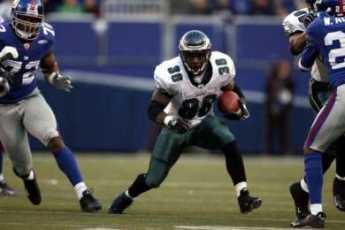
Mohammed Ali, Cassius Clay
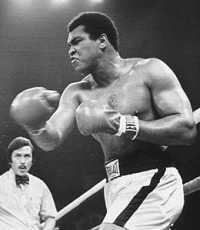
|
| Mohamed Ali |
He doesn't live there any more, but for a long time Mohamed Ali the Prizefighter lived in Cherry Hill, New Jersey. Although a celebrity, he made little local news in Philadelphia; comparatively few Philadelphia's even knew he was here. One day, my ten-year-old son came in the house with a check endorsed by Ali for a hundred dollars or so. It had apparently flown out the window of a passing car, and my son was very excited to have the autograph of such a famous person. There was an ethical question here, since the check was apparently worth something to its owner, and should be returned. My suggestion was followed to mail the check back with a note suggesting that perhaps the Great Man would be willing to send his autograph as a reward. The check was accepted, but the letter was never answered, no autograph was forthcoming.
Since that time I remained a little irked that Mohamed Ali would be ungrateful for the favor, unwilling to take a little trouble to help me teach my children the right thing to do. That small, perhaps unwarranted, irritation was balanced by reports from a respected friend of mine who was his doctor. My friend always referred to him as "Champ" and never failed to praise him as a person. Perhaps the check incident had been some sort of accident, something I should overlook.
There were those news reports, of course, of his refusal to accept the draft, his public conversion to Muslim faith and adopting a frankly Muslim name at a time when the perception was that black Muslim had the significance of a prison cult, both anti-American and anti-Western Society, perhaps even racist. Surrounded by news media as he was, he became a symbol of resistance to the Vietnam War and American foreign policy. It was hard to know what to think of him, but on balance it was unfavorable, even when he was reported to be incapacitated by crippling Parkinson's disease.

|
| sports |
And then recently, The Constitution Center held a forum on the relationship between sports and the media. The point was repeatedly made that a sports career is brief, that financial success in it depends heavily on fast and early publicity. All publicity is good publicity, so outsiders who seek to publicize a political agenda can often put their words into the mouths of eager kids who are being privately urged to grab publicity of any sort, anyway they can. You tell me what to say; I'll say it. Make me sound clever and serious; I'll agree to your words.
It thus happened that a reporter who had been covering Mohamed Ali for 25 years and knew him well was able to say he was certain the Champ had never had a political thought in his life. Having been pressured by others into making political noises for celebrity purposes, and perhaps under some intimidation by acquaintances, he finally rebelled against the whole scene. Respect for a man I had never met finally welled up in me when I thus saw his famous quotation to the press in a new context: " I don't have to be -- what you want me to be."
Paul Robeson 1898-1976
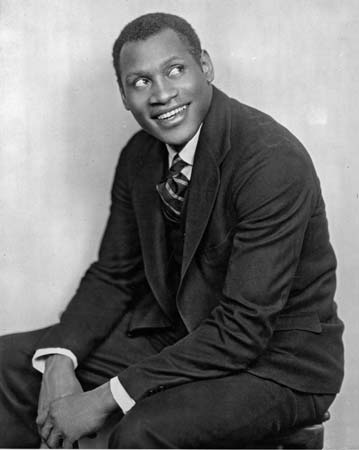
|
| Paul Robeson 1898-1976 |
Everyone with international fame and fortune seems to belong to another planet, but Paul Robeson belongs to the Philadelphia region as much as to any locality. He was born in Princeton, of a black minister who went to Lincoln University, and a mother of Quaker heritage. Not only an All-American football player, but he also won twelve varsity letters. He not only was accepted to Columbia Law School, but the only black person in the class became its Valedictorian. Later on, his amazing baritone voice made him the perfect person to sing "Old Man River" in the musical Showboat, and quite a different dimension emerged in his highly memorable portrayal of

|
| Paul Robeson as Othello |
Shakespeare's Othello. He was combative athlete, nobody's fool, and had a commanding stage presence. It was scarcely surprising that he resented the social slights he encountered in his upward mobility, or in a time when many people -- not just in show business -- were leaning leftward, that he frightened people with his praise of Communist Russia and seeming incitement of his race to rebellion.
Probably the first false note in this tragedy was his resignation from a prestigious New York law firm because a white secretary insulted him. No defensive explanation from his admirers could quite justify this unlikely story of a promising career cast aside for a trifling affront. Some of his foreign travels may have been entirely motivated by a search for social progress, but his several hospitalizations abroad do raise the possibility that he hoped to avoid publicity about his illness. The last two decades of his life were destroyed by undeniable mental illness. There are schools of the psychiatric theory which contend that depression can be caused by severe life stresses, but majority opinion now mostly views such illness as an inherited disorder. In any event, he was born too soon. In recent years, the treatment of depression has much improved.
The failure of early promise is an old story, but in Robeson's case, it was far more than personal decline, and more the hunting-down of a wounded animal. The son of an ex-slave, Robeson evoked memories of slave rebellions in the past with his mournful song of the Mississippi laborer, as did his vengeful destruction of the innocent Desdemona. His exploiters in the entertainment industry probably deserve some criticism for pushing him too far into a rebel image, and the ruthless manipulation of communist agitators during the 1930s is not a myth. So, there was really not much to prevent Senator Joseph McCarthy and his associates Cohn, Shine and Kennedy from converting the post-war fears of the nation into a circus of fearful demagoguery. Millions of people had just died in foreign wars, nations had been reduced to rubble, and vengeful heedlessness was on every side. It was not a pleasant time.
More than twenty years later, Paul Robeson died where he had been living with his sister, in West Philadelphia.
New Phillies Stadium
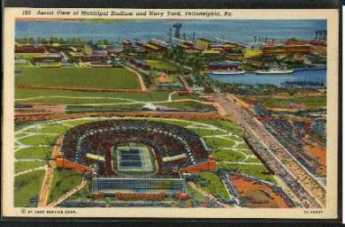
|
| Phillies Stadium |
Built to house the Dempsey Tunney prize fight, we have seen six stadiums built there in one lifetime, a seventh in prospect, and three torn down. Building stadiums well are not the same as playing sports well, just as buying cameras is not the same hobby as taking photographs. In both cases, it is possible to get confused as to what hobby you are trying to excel in. Anyway, we have just opened stadium number six, for baseball, named Citizens Bank Stadium.
The new baseball park holds 43,500 spectators, and recently it fills to capacity. There are four or five million people in the region, so if everybody goes there just once to see what it looks like, it should stay full for four or five years. On the days of baseball home games, that is, since it is dead empty for away games, and on days when football and basketball are played in the nearby stadiums dedicated to those sports.
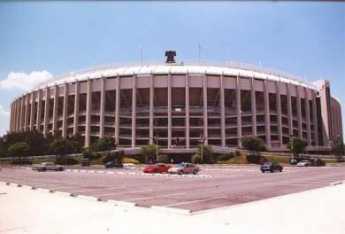
|
| Veteran's Stadium |
That is, at best it will be empty most of the time. New tickets will be $90 apiece in really choice sections, not to mention the corporate boxes, and the ordinary first-class tickets will be $40. The most expensive seats in the old, so-called Veteran's Stadium, were $28. You can take that either way. Perhaps we are pricing ourselves out of major league baseball. And perhaps a willingness to fill the stadium at these new prices is a sign we should have built a new ballpark long ago.
The first step in building Citizens Park
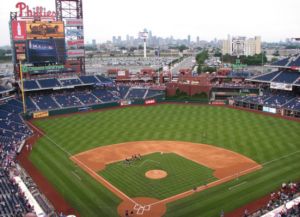
|
| Citizens Park |
was to dig a big hole in the ground. The playing field ends up twenty-five feet below ground level, so that half of the people who arrive at the park will walk downstairs to their seats, and half will walk upstairs. Never mind; when the game is over, the ones who went down will have to climb up, and the people in the balcony can walk down. That's pretty fair. Of more concern is the water level of the former swamp between two rivers. It was necessary to put in a powerful set of pumps to keep the stadium from turning into a lake. If the power goes out for any extended duration, some interesting photographs could emerge.
It's reassuring to know that the Veteran's was built along the same principles.

|
| Vet Stadium Implosion |
When the Vet was famously imploded into a pile of rubbish, the disintegrated remains of the stadium didn't quite fill the hole. Here's some forward planning, all right. If we are in the business of constructing serial stadiums, the cost of this hobby is appreciably reduced by incorporating the self-service rubbish removal feature. If there are other features like this one, perhaps this stadium collecting hobby isn't as expensive as it sounds.
Cricket Fanatics Say Baseball is for Sissies!

|
| Alan Lawley |
Philadelphia still has six cricket clubs, and used to have more. The game of cricket was invented in 1200 AD and had its rules established in 1749 at the Marylebone Club. Baseball, on the other hand, was established in 1849 by Abner Doubleday of Cooperstown New York, with the convention of confining the runners to a diamond infield. Modern rules and established leagues of players only came along twenty years later. Actually, no one disputes that cricket is older. The question is one of manliness. Having listened for centuries to American jibes about tea and watercress sandwiches, the crickets have had enough. Their champion, Alan Lawley, recently threw down the challenge to baseball-crazy Americans at the Philadelphia Right Angle Club, where Lawley is Recording Secretary. Pardon me, blokes, but why do you tough guys consider it necessary to catch the ball with those big leather gloves? Don't you notice that cricket players catch the ball with their bare hands? Most of the excitement comes at that moment when the player is circling to catch the batted ball. He'll get it all right, but will he drop it? The essential inferiority of baseball to cricket has been documented for pages and pages by legions of British subjects, but the main point is about those gloves.
So the challenge is out. Let's see you gashouse beer drinkers take off those big protective mitts, and then try to catch the ball. And while you're at it, let's hear you pronounce Marylebone.
Rugby in Our Midst

|
| Cricket |
American sports fans are incorrigibly provincial. The rest of the English-speaking world plays cricket, but Americans play baseball, which is vaguely related. You wouldn't know it in America, but world-wide, cricket is much more widely played and followed. American football is a vague relative of rugby; here, it's a little harder to say which of the two is more popular. The complicated and expensive padded uniforms of football push the game into varsity and professional teams, with droves of spectators. Many more rugby fans, even reasonably elderly ones, are actual players. But both games are played with a funny-looking ball with two pointed ends, and both of them score points by drop-kicking or place-kicking the ball over the horizontal bar between two upright goal posts. In the case of both cricket and rugby, the players hardly stop playing for hours, while the Americans are forever stopping for time-outs. There's a question of manliness here, but very likely the stop-go nature of both American football, and baseball, is also a response to the need for commercials on television. Catching a hardball with a big leather protective mitt, like the wearing of heavy football equipment, is a little harder to defend on the manliness feature, but the usual response is that the American games are so much faster and rougher -- protective devices are justified by common sense.
Well, that's all as may be. The more scholarly approach to game analysis goes back to the custom of Nineteenth-Century British boarding schools of having their own rules. Rugby School definitely started the game of Rugby from its origins in football, which Americans call soccer. When two teams met, the captains would agree on the rules of the day, so it was fairly easy for such games to evolve in many directions. And eventually, you can see why it was necessary to freeze the rules into some sort of international agreement. Captains of two teams who are setting today's rules will naturally attempt to play by rules that give some sort of edge to particular players on their own team. Bookies won't stand for that.
Yet Another Toast to Dr. J. William White
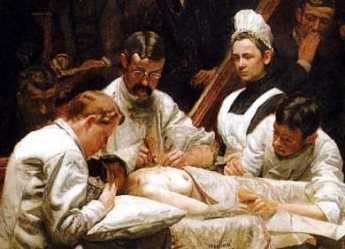
|
| Dr. J. William White |
Who was Dr. J. William White, and why do we drink a toast to him every year at our Annual Meeting?
I will answer my second question first: Dr. J. William White died on April 24, 1916, leaving a Will that he finally signed only on March 24 of that year. The Will, drafted by John G. Johnson, the most famous Philadelphia lawyer of that time, runs to 26 pages and disposes of an estate of $868,176.05,--which was real money in 1916.
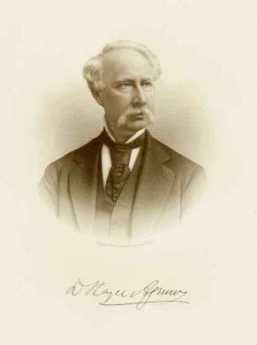
|
| Dr. David Hayes Agnew |
Item 17 of that Will reads as follows: "I give to the Franklin Inn Club of Philadelphia five of its bonds of $100 each to me belonging.
IN ADDITION TO THIS, I give to said Club the sum of $5,000 to be invested by the Directors of the Club, with the approval of the majority of the membership, and the income to be expensed in such way as will best subserve the interests of the Club and conduce to its perpetuation.
I will be glad if, in doing this, they can assure the occasional remembrance of my name. The Club has been of me the source of so much pleasure and happiness that I feel that I owe it something in return."
Well, I have not examined the minutes of our Board to see if it really was discussed and voted upon by a majority of the members, but when I joined in 1968, I was told that Dr. White's bequest had been used for this annual dinner in his memory as long as there was money to pay for it, then only to buy the champagne for the toast to his memory, and then in my time even the champagne money was drunk up.
We still talk about him. He was in every sense a "character", a special Philadelphia character. A lot of this information comes from a biography his friend Agnes Repplier published in 1991. J. William White's father James William White Senior was a doctor, the founder of Womens' Maternity Hospital, and President of the S.S. White Dental Supply Company, an extremely successful business which operated until recently from a big building just down there on 12th Street. The Money that flowed from this business enabled our Dr. J. William White to do pretty much what he wanted all of his life.
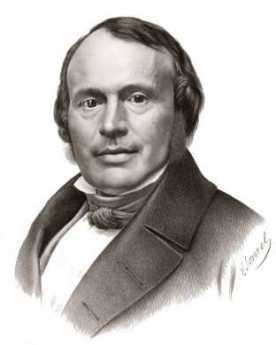
|
| Professor Louis Agassiz |
He was a very smart boy, strong, and with a bad temper. He got into fights at school, but he also managed to earn both an MD and Ph.D. from the University of Pennsylvania in 1871, at the age of 21. He maintained a passionate loyalty to Penn all of his life. Directly after graduation, he obtained a job on a U.S. Coastal Survey ship, theHassler on a survey of marine life and ocean bottoms conducted by Professor Louis Aggassiz of Harvard. He was hired as a "Hydrographic Draughtsman" but it turned out he was to be the expedition photographer and film developer because nobody else knew how to do that. Before they sailed, he also wangled a job as correspondent for The New York Herald. They sailed from Boston in December 1871, explored their way around South America and arrived in San Francisco in August of 1872. On his way home by train, young Dr. White stopped in Salt Lake City to hear Bringham Young preach. Bringham Young preached against doctors and lawyers, and told the women in his audience that they should not employ obstetricians, that they and their babies would be better off without them.
When Dr. White returned to Philadelphia, he went to work, first as a resident at
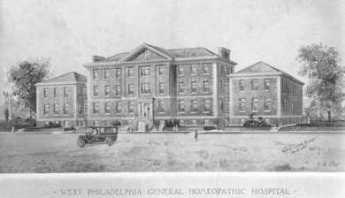
|
| PGH |
Philadelphia General Hospital, then a doctor for Eastern State Penitentiary, where he apparently lived for a while, where he took boxing lessons from a giant prisoner. By 1876 he was an Assistant Demonstrator of Practical Surgery at Penn, and a couple of years later he was working under the most prominent Philadelphia surgeon Dr. D. Hayes Agnew. In Thomas Eakins' famous painting "Dr. Agnew in his Clinic" we can see Dr. White doing the actual cutting, while Dr. Agnew is giving the lecture.
This picture is also interesting because
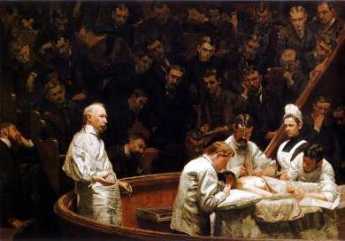
|
| Agnew Clinic |
right there in the middle of the action is a stalwart female, the surgical nurse. By the time of this picture, both Drs White and Agnew were having trouble with the Board of Governors: female students were complaining that they were not allowed into these clinics.
Drs Agnew and White replied that "the nature of the diseases and the conditions of the patients made the presence of females undesirable."
The doctors offered to quit and the Governors apparently backed down. But what about that nurse?
Another famous story: In 1877 Dr. White was elected to the First City Troop
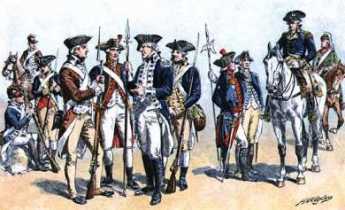
|
| First City Troops |
. For some reason, this didn't look right for a young doctor, because in these long years between wars, the Troop was known more for parties, banquets, and balls than for national defense. However, he joined, enjoyed the parties and the riding. Previous Troop surgeons had worn regular street clothes; Dr. White put on the fancy Troop uniform. Probably at a party, a Trooper named Adams objected, became loud. Dr. White floored him. Mr. Adams sent a formal challenge to a duel.
Sensation! Nobody could remember a duel in Philadelphia, where it was against the law. The newspapers were in an uproar, the New York Herald,
for which Dr. White once wrote letters from his voyage around South America, invented a story about a lady who was supposed to be the real cause of the fight. Mr. Adams and Dr. White, accompanied by seconds and a surgeon, crossed the Mason-Dixon Line, took single shots at each, shook hands and went home. Dr. White shot into the air. Years later, Adams confessed that he had aimed at Dr. White, but missed. Eventually, the storm blew over, but it is remembered as the last duel around here -- as far as I Know.
As to the City Troop, Dr. White's Will left $5,000 in Trust for a "J. William White Fund, the income to keep remembrance of the facts that I served as Surgeon and was the first incumbent of that position to be directed by the Troop to wear the time-honored full dress uniform."
I don't know if the Troop bought champagne to keep remembrance.
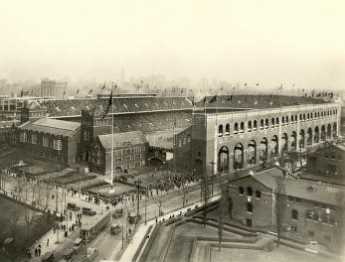
|
| Franklin Field |
Although Dr. White became one of the best surgeons here, and wrote several successful textbooks, he is mainly remembered for his passion for athletics. He was made the first Director of Athletics at Penn.

|
| Army-Navy Games |
He built the first Gymnasium, he built Franklin Field, he arranged for Army-Navy Games to be played here, he got his friend Theodore Roosevelt to attend, he spent every summer either climbing the Rockies or climbing the Alps together with his very sporting and strong wife, Letitia.
Letitia was also a better shot than her husband.
Perhaps Dr. White's most famous sport was called "Angling for Men". He learned this sport on vacation in
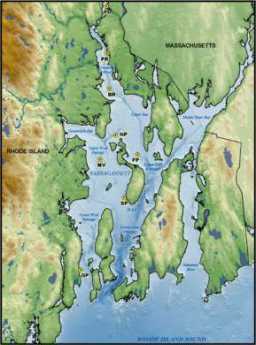
|
| Narragansett Bay |
Narragansett Bay. The players are in a rowboat, and the contestant jumps into the water, with a strong rope tied around his waist. The Men in the boat try to haul the Swimmer back into the boat, while he resists. When Dr. White was 46 years old it took three of his friends 38 minutes to get him back within 100 feet of the boat, but they never got him in!
Dr. White moved in very exalted circles. Among his close friends were Henry James,
whom he visited in Rye and who lived with the White's on his visits to Philadelphia: John Singer Sargent, whom Dr. White persuaded to paint his portrait although Sargent had given up portraits; and the famous English doctors Sir Frederick Treves and Sir Joseph Lister, and as I said, President Theodore Roosevelt.
In later years, after retiring from regular surgery, Dr. and Mrs. White traveled all over the world, although some patients including John G. Johnson insisted that only Dr, White could do any procedures upon their own bodies!
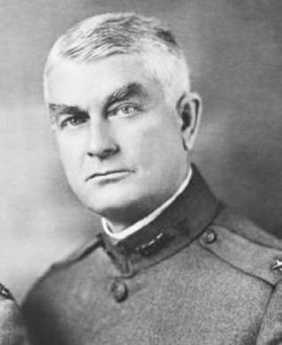
|
| William Mayo |
Well, of course, Dr. White had his own problems, and like all men, became a patient himself. In 1906, he developed a hard nodular mass in his left iliac fossa which, I gather, is not good. Probably cancer. He knew what to do. He took a train Rochester, Minn. To his friends the Mayo Brothers. When they decided to operate, three top surgeons from Penn went out to watch. Dr. William J. Mayo operated and successfully removed congenital diverticulitis which had caused a perforation of the bowel.
Later: Dr. Mayo: "Well, you're all right."
Dr. White "Well, you're a good liar. I've been there myself, and I know."
Dr. Mayo: You don't know everything. It's like a bag full of black beans, and one white bean. You pull out the white one. Now get well!"
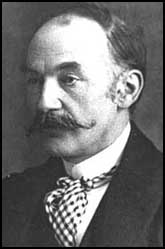
|
| Thomas Hardy |
By next summer he was well and traveling again. He received a degree from University of Aberdeen, he met Thomas Hardy, he went to Egypt, next year to China, when the First World War began he was passionately pro-Allies, visited friends in London, visited wounded soldiers at the American Ambulance Hospital in Paris, spent much time there but did not operate, flew over the battlefields in a French military plane, and visited Reims during a German bombardment. He visited the British front, returned to London, involved himself in the issue of Henry James becoming a British citizen because of America's Neutrality, then sailed home across an ocean full of U-Boats.
Back in Philadelphia - actually on his estate in Delaware County he raised money for the American Hospital in Paris, and again involved himself in several disputes, about the War, about a Penn faculty member...but now he was dying, we're not clear from what, but it sounds like cancer, after all. He was in great pain and had to be hospitalized. He died in his beloved University Hospital, surrounded by colleagues and friends, on April 24, 1916.
I close with a few more words about his Will. As I said, it is 26 legal-size pages, really the story of a life, packed with bequests to every person who was close to him, every organization he belonged to-- and most of them, like the one to us here at the Inn, ask that something be done to remember J. William White, which seems --to me -- little sad. Why were this popular, successful men so afraid of being forgotten? Was it because he and his wife had no children?
I don't know, but here, tonight, we remember: I raise my glass-- champagne or not--to the memory of Dr. J. William White, a character if there ever was one!
------given at the Franklin Inn Club on January 14, 2005, by Arthur R. G. Solmssen
Forty Days Before the Mast
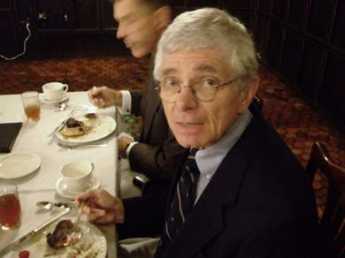
|
| Dick Watson |
Most Americans would like to lose weight, particularly if they could eat, and eat some more, at the same time. Dick Watson recently told the Right Angle Club about an adventure cruise on a sailing ship in the South Pacific, where he and everyone else ate huge mounds of delicious food, but still lost 12 pounds in a month. About twenty of these voyagers spent eight thousand dollars for the privilege of working as sailors for a month on an authentic pre-steam brigantine, sailing from Aukland to Easter Island. Dick took fourteen hundred beautiful photos of the experience, but most of his audience sat transfixed at the description of the horrors of sailor life. Not your average luxury cruise.
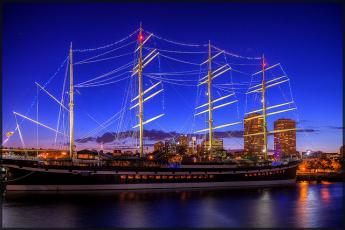
|
| Moshulu |
A brigantine is about an eighth the size of the Moshulu parked in Penn's Landing, and definitely does not plow the waves. Bobbing like a cork with every ripple, the ship "rode" waves throughout this "Pacific" cruise that averaged six meters or about twenty feet high. It thus follows that every single voyager was deathly sea-sick for the first two or three days; welcome to the bounding main. In spite of excruciating incapacity, sailors are not excused from standing watch; that's just about the first law of the sea. However, after a few days, this problem seems to go away for almost everyone and becomes only an initiation rite in retrospect. What doesn't go away is the wind, the cold, and the rain. Climbing the rigging gets you up to the fighting top, a wooden platform forty feet above the deck. Bigger ships sometimes have a hole in that platform to crawl through, but brigantines don't have rubber holes. You climb the mast and work your way out to the edge of the platform hanging upside down, then drag yourself up and over the edge. Once you are there, you can attach your safety belt, but the transition depends entirely on having enough strength in your hands to hold on while the ship rocks from side to side, forty feet below. Above the fighting, the top is another fifty feet of climbing, as the shrouds (ropes) which are attached to the top narrow down to the point where there is no longer room for your foot unless you turn it sideways. Ballet dancers learn to walk on their toes, but walking and climbing on the side of your foot is a step beyond excruciating.
Perhaps it is the good thing our ancestors came over to settle America that way. Except for a few people like Benjamin Franklin they gladly gave up all thought of returning to the home country. However difficult it may have seemed to cope with the Indians and all, they were going to be Americans forever. Other people could fight wars about events that took place in 1384. We weren't going to worry about that sort of thing because we were not going back, ever.
WWW.Philadelphia-Reflections.com/blog/1323.htm
Dog Days
Teddy Roosevelt was a great conservationist, promoting the outdoors life, establishing the National Park Service and so on. At the same time, the walls of Sagamore Hill his home on Oyster Bay were covered with the stuffed heads of big game animals he had personally shot for no better reason than it pleased him to shoot them. This paradox is a convenient symbol of the mixed-up ideas and conflicted attitudes of the public at large about animals. We love them, but we also eat them for dinner.
The two sides of this tension have at their extreme some pretty rich nut cases, or some pretty nutty rich folks, however, you wish to style them. One woman has bought half the country of Paraguay for a nature preserve. On the other extreme, it is said that one wealthy Philadelphia lady has contributed enough money to attract the solicitude the Governor, in the interest of animal rights legislation. Since his political enemies call him "Fast Eddie", that isn't his usual image. It is rumored that he loves his pet terrier, but the center city cynics gathered around lunch tables on Camac Street surmise that his really influential friends could be real estate developers. This all does require a little explaining, which is a full-time occupation in some circles.
Jim Scharnberg was entertaining Inmates the other day about his almost full-time avocation of hunting rabbits in Chester County with a pack of French hounds. Hounds, mind you, not dogs. There are thirty clubs in Chester County alone concentrated on packs of hunting hounds, not to mention all the other counties in the state, and not to mention the hunters on horseback, the fox hunters, the deer hunters, and lots of other kinds of hunters, sometimes with but mostly without guns. Most of these groups have frequent outings together in the countryside, followed by jolly dinners and gatherings, and with newsletters, websites, intermarriages and lots of other associations. Social scientists would call these networks, a trendy phrase, that..
To illustrate how easily networks are formed between hound lovers and politicians, Jim tells the story of living in Manhattan near Gracie Mansion, with his hounds of course. Hounds have to be walked, you see, and the New York police are not particularly friendly to the idea, nor are other inhabitants of the skyscraper canyons, who promote pooper scooper laws and encourage police harassment of hounds. One evening a dog belonging to a native New Yorker was attacked by 27 East River rats. Jim's hounds were unleashed, the dog was rescued. It turned out to belong to Mayor Lindsay, who was quickly persuaded to create special privileges for hounds in Carl Shurtz Park and other East Side grasslands.
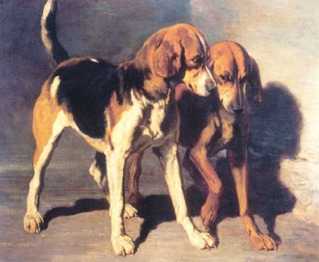
|
| French Hounds |
Some members of hound packs are into the whole thing, as Jim is, but most members merely enjoy an excuse to wander in the outdoors with convivial company, or else enjoy the parties afterward; some people just like to write newsletters and send out meeting notices. Everybody likes to talk, that's one sure thing. These things flourish in the exurbs, the farm areas just beyond the edge of development. In Chester County, such farmland is quickly disappearing at the rate of 13,000 acres a year as real estate developers find it is cheaper to build in the countryside than where you have to tear down old buildings to build new ones. Inevitably, the people whose ancestors started the farms 300 years earlier are upset at seeing the old place go. There's an economic issue as well, because farmers need local canneries and wholesalers to take their farm products; these support systems tend to wither as farming gets sparser. And the new neighbors are not accustomed to farm sounds or farm smells. The idea of living next to a pig farm is not softened by the knowledge that the pig farm was there first. Perhaps you get the idea; conflict is how politics gets into it, and these are the networks who will prostrate themselves in the middle of the highway to preserve their heritage. All it takes is a couple of rich ladies to get excited enough to donate lobbying money, and wondrous inanities can get taken seriously. There is now a bill before the Pennsylvania Legislature which in other times would be referred to as a "tickle" bill, one of ten thousand annual bills submitted by legislators to placate constituents, but widely observed never to go anywhere. But put some serious money behind a tickle bill, hire a few consultants who know exactly which levers to pull and which clauses to include for support, and you could have a law to air condition all dog kennels, thus making Pennsylvania the laughing stock of the country's legislative circles. There can be rules governing the size and cleanliness of dog runs, rules about Fido's required breakfast content, and rules to sterilize every domestic animal so that in one generation we will be animal free.
Grown ups are actually saying such things, and legislators are growing afraid to oppose them. Back home in the real estate office, everybody can be all smiles. Because this is how you can get some nice zoning changes if you play your cards right.
Camden Riversharks
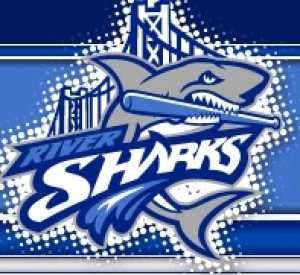
|
| Camden RiverSharks |
Just about the cutest baseball park anywhere is Campbell's Field, best seen out the windows of the PATCO highspeed train as it crosses over the Ben Franklin Bridge into New Jersey. It's a regulation-size playing field with gleaming green grass, but comparatively small seating capacity. It's a great novelty to sit in the front row and have the umpire come over to chat, or to scold one of the players for spitting chewing tobacco. As told by Joel Seiden to the Right Angle Club, the performances of the home team Camden Riversharks is more about serious entertainment than serious baseball. On certain nights, there are fireworks, and free strawberry sundaes, and comedy. The finger food is cheap by professional sports standards, so it's a great place for dads to take their Little Leaguer sons.
About three-quarters of the audience usually come from New Jersey, and that's where team loyalty centers. There is hope that when the tramway to Pennsylvania finally gets built, or possibly the gambling casinos, more traffic will come over from Philadelphia. The greatest advertising comes from ordinary commuters, looking down from the bridge on a summer evening. A typical audience will be 3700 fans, rising to about 6000 on weekends.
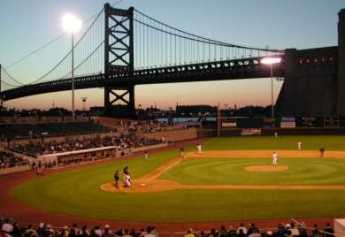
|
| Campbell Field |
Although Campbell Field has a band-box new sparkle to it, it's had something of a bumpy financial history. It was built by Steve Schilling for $20 million with a promise to support yearly losses up to a million dollars annually. Unfortunately, he died young, leaving a will that prohibited further support, and sort of a tangled financial structure. As part of an effort to stimulate a Camden renewal, the Delaware River Port Authority loaned $8.5 million, Rutgers Camden owns the field, and Sovereign Bank put up a mortgage. Investor groups have expressed interest, Sovereign Bank has threatened foreclosure, and wrangles which have very little to do with baseball have dominated the private affairs of the team.
Because of the exemptions from antitrust which are exclusively available to organized baseball, no minor league team affiliated with a major league team may play within fifty miles of a major league team. Therefore, the Riversharks are an unaffiliated team, playing in the Atlantic League of Independents. However, this creates a source of revenue from selling promising players to major league scouts (Price: $5000). Since there is a top salary limit for players of $3000 a month, most players have a second job. They are professionals, but not exclusively professional. About 7 players are bought every year.
So, everybody involved struggles just a bit, but it adds to the gossip and buzz. So, take a trip on the PATCO train to the City Hall Station and walk three blocks, or take it to the Broadway Station and then the Riverline down to the field. Lots of fun.
www.Philadelphia-Reflections.com/blog/1416.htm
Lawn Tennis at the Cricket Club
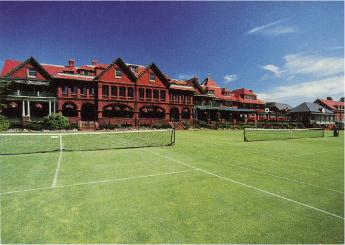
|
| Merion Cricket Club |
Lawn tennis isn't terribly ancient, having originated in England around 1880 as a variation of badminton which was brought back from India during the days of the British Empire. As the name suggests, it was originally played exclusively on grass courts, which proved hard to maintain. It was supplanted for a while by clay courts, and more recently by hard and artificial surfaces. Lawn tennis on lawns has largely become a game for the rich because of the cost and difficulty of maintaining a playable surface in hot weather.
If you wander into the Merion Cricket Club you'll find lawn tennis in the grand style, viewed from luncheon tables under a roofed porch. The long relatively narrow porch is right up against the grass courts, but it's also sort of a Peacock alley where well-groomed young ladies show their stuff, and everybody at the tables wishes to seem to know everyone else. There are times when the athletic entertainment becomes cricket out there on the field beyond the porch, but a larger proportion of the lunchers turn their backs on the field during that season than when exciting tennis championships are reaching the finals.

|
| "Lawn" Tennis |
In addition to being more expensive to maintain the courts, tennis on the grass is a different game from tennis on a hard surface, like clay or asphalt. The ball tends to skid when it hits the grass, so it is more effective to volley it before it hits or before it takes much of a bounce. The bounce tends to be more nearly straight up, while on harder surfaces the ball bounces at a low angle. Either way, the consequence is a tendency for a faster game on grass. The players run harder to get the ball at the bounce, and the advantage goes to those who serve hard and return the ball hard -- and fast.
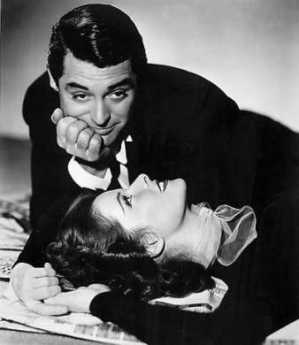
|
| Cary Grant and Kathryn Hepburn |
The rather special nature of the game adds to the up-scale atmosphere. And makes it just as attractive for the Kitty Foyles at the tables, as for the Kathryn Hepburns, both of whom have their own attractions for the Cary Grants. The parking lot is also a good place to form an opinion about the latest in high-priced autos.
www.Philadelphia-Reflections.com/blog/1494.htm
Shad
Nowadays, we have fresh fruit and vegetables all year Shadround. When produce isn't in season locally, we get it from Florida and California. When even those places are out of season, we bring it in from Chile. But the supermarket and its attendant supply chains are recent phenomena. Before the two World Wars, our food was pretty drab and monotonous during the winter. The first sign of the culinary joys of spring was shad.
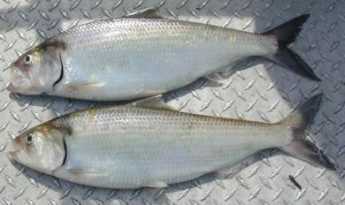
|
| Shad |
Everybody loved, which everybody ate in its various forms. Shad was cheap because it was abundant; indeed, it seems difficult for the modern fisherman to imagine the huge quantities of fish that came up the rivers in early March. There was even a special term for fish weighing less than three pounds; at the fish market, such fish were thrown in, free. The term "Bushwacker" referred to the practice of beating the fish in the water to catch them. There once was a time when everybody knew how to use a shad dart, everyone could filet the bones, everyone had fried shad roe for breakfast. Spring, it was acumen in.
Unfortunately, the diversion of fresh water from upper Delaware to New York City, the dumping of waste from the oil refineries near Marcus Hook, and heaven know what other pollution, wiped out the annual shad run. Once a river's shad run is depleted, the main obstacle to getting it revived is the striped bass, who feast on the fingerlings coming back downriver from the spawning areas. You can still catch a few shad at the place where Amtrak crosses the Susquehanna, and a few hardy pioneer fish are starting to make it all the way to Lambertville. But the bulk of shad in Philadelphia markets now comes from North Carolina, and you better be alert to your timing or even they will be all gone before you've had any. There once was a time when a diner could be identified as a boorish stranger picking gingerly at the strong-tasting fish, or messing around dubiously with the unfamiliar roe served on toast. Nowadays, even lifelong Philadelphians will occasionally behave like that. You put lemon juice on the roe, dummy.
And you filet the fish. The bones of a shad are complex, going both forward and back within the flesh, so you have to be experienced to take a very sharp knife, twist, and turn, duck your shoulders and flip the fish, to produce boneless" shad0. If you don't know how to do that, you may have to bake the fish for hours to melt the bones and make it edible, but tasteless. Such products can be rescued by stuffing them with bread crumbs and spices. When things reach the point where no butcher knows how to produce boneless shad, our culture is on the edge of extinction. The big center for wholesale boned shad is Dill's in Bridgeton, NJ. There is, right now, only one place where you can obtain planked shad. That's the Salem Country Club (if you look respectable they let nonmembers in) out at the point on the Jersey side where Delaware takes a big bend before it flows down to the sea. A shad is planked by splitting it open and nailing it to a board, which is then placed before an open fire in the fireplace. Snap, crackle and wow.
Maybe the conservationists can get these fish back for us. The Eagles will certainly like that; had used to be what mainly sustained the American bird, and the depletion of the shad is part of the near-extinction of eagles. And maybe we can swallow our pride and teach the West Coast how to treat shad with respect. Shad was always an East-coast, Atlantic fish, and there is hardly a river left which has much shad. But someone transported some shad to the Sacramento, California area a century ago -- and they have flourished. Where the fish ladders of the Columbia River used to teem with salmon, nowadays they teem with shad. California likes to think it invents everything in America. Brace yourself for being told they invented shad.
Skating and Humane
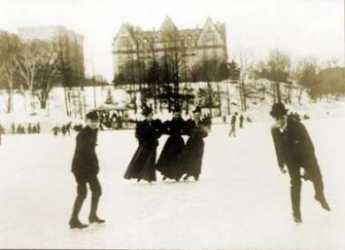
|
| Outdoor Ice Skating |
There was a time when ice skaters and rowing enthusiasts were having a little war on the Schuylkill, and the rowers won. We are indebted to our dear friend the late Elmer Hendricks Funk MD, a past president of the Philadelphia Skating and Humane Society, for some of the history.
Ice skating is both dangerous and seasonal. In the Eighteenth Century, ice skating was concentrated near the center of population on the Delaware River, and that's where you found the Skaters Club. You also found the Humane Society, whose main function was to pull drowning skaters out of the water. The Humane Society got to be quite rich because people were inclined to be sympathetic to lifesavers. In time, however, people moved away from Delaware and the two clubs, Skating and Humane, merged. No doubt the skaters thought they would be acquiring the substantial endowment of the life-saving club, but in fact, the Pennsylvania Hospital got most of the money in one of those genteel struggles that volunteer organizations sometimes get into. Skating moved from Delaware to the Schuylkill, and the club built a little house on what is now boathouse row, right next to the lighthouse.
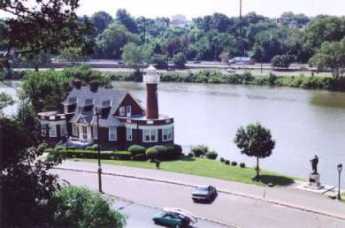
|
| Turtle Rock |
The lighthouses at Turtle Rock was useful for the southern terminus of the canal just across the river on the West Bank, and for many years there was a little canal house on the Westside, making it easier to see what this was all about. The lighthouse became incorporated into a boathouse for the first women's rowing club, but the club died out and this combined, Sedgley, is now a women's luncheon club. Next door was the Skaters and Humane, fighting to survive among all the rowers. Since rowing has a much longer season than skating, the skaters feared they would be overwhelmed. They passed a club by-law that no officer of the club could be a rower.
However, the skaters had another enemy in the ice companies, who tended to chop up the first and best ice to form in the area. And the final blow came when the Arena was built at 45th and Market Street with artificial indoor ice. So, the boathouse became the home, in 1938, of the Philadelphia Girls Rowing Club, and the skaters and lifesavers moved first to the Arena, and then to Ardmore. Haverford College was glad to sell them a swamp they owned there since it wasn't much good for a college but the local springs provided needed water for the skating rink. With a rink, skating became year-round, and there was a roof to protect against snow and rain. You can't fall through the ice in a rink.
The club had a number of lucky breaks by being first, constructing its building cheaply in the depression, being able to use ammonia as a refrigerant, and getting cheap land. There are other skating clubs, but few of them own their own rinks, and no other skating club has the national prestige of the Philadelphia Skating and Humane Society. It is the oldest, the first, the best, and the most famous. If you are anybody in skating, this is where you want to skate.
SCUBA Tours of the Andrea Doria
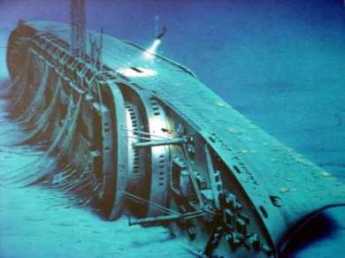
|
| The Andrea Doria Wreck |
Robert J. Burns, who runs clinical trials of medical instruments at Boston Scientific, on July 25,2008 told the Right Angle Club about what he does on weekends. It seems to amount to coming within an inch of getting killed, scuba diving. His favorite place to visit is the sunken wreck of the Andrea Doria, lying on its side in 250 feet of water, forty-five miles from Block Island in international waters. Built in 1951 in grand style, the Andrea Doria was the pride of the Italian ocean fleet, with 190 First Class passengers, 267 Cabin Class, and 677 Tourist Class. There were about 600 crew members aboard. Two of the passengers on July 25, 1956, were Mayor Richardson Dilworth of Philadelphia and his wife, so when it sank, the Andrea Doria dominated the news. After it was all unscrambled later, it seems the radar of the liner Stockholm had incorrect markings and misled the helmsman into thinking distances were five times greater than they actually were. On a day of dense fog, the Stockholm knew the Andrea Doria was near, but greatly underestimated how near. When the Stockholm suddenly found the Andrea Doria looming up, the helm was sharply turned in both ships, causing the prow of the Stockholm to gouge out most of the side of the Doria, which soon sank. That would ultimately mean the Stockholm was mainly at fault, but the Italian liner's image was as damaged as its hull by having the crew commandeer the lifeboats for themselves and essentially abandon the passengers. The rescuing ship was the Ile de France, who told the newspapers that at first, they thought they were rescuing an all-male ship. It's not completely certain how many people were killed in the collision; between 47 and 52 individuals were missing. A matter of great interest to the news media was the story of an 11-year old girl on the Andrea Doria, who was scooped out of her cabin by the prow of the Stockholm and eventually located safe and sound in the bow of the Swedish ship.
Because of German submarine activity in World War II, the Atlantic coast is littered with sunken ships from Boston to North Carolina. Most of them attract great schools of fish and scuba divers, but the Andrea Doria is a favorite because of all the souvenirs to be found on it. Three classes of dining rooms provide tons of monogrammed dishes and tableware, greatly in demand for the trophy cabinets of avid scuba enthusiasts. Just about the first salvage hunter was Peter Gimbel of the department store family, who cut a hole in the first class area and liberated the safe which might be presumed to be full of jewels. As it turned out, it only held some well-soaked Italian currency.
Scuba diving at a depth of 250 feet requires a certificate, and $7000 worth of training for five years is required just to be eligible to risk your life. Even so, plenty of people have lost their lives playing this game, whose central thrill seems to be that you have to get dozens of maneuvers right, every single time, or you've had it. The Martini effect is probably a big part of it, too. Every fifty feet of depth gives a degree of narcosis equal to drinking one Martini, so a diver to the Andrea Doria operates as if he had drunk five Martinis. Under those circumstances, judgment gets clouded but every single knob on every single hose has to be adjusted every so many minutes, adding and subtracting oxygen, substituting helium for nitrogen, and modifying the pressure and flow rates. Then, because it's dark down there, you have to remember to turn left after ten feet, then right after twenty feet, and reverse it all when you come back out with your monogrammed dish. Deep sea diving with a hard hat is safer and more comfortable because you are attached to a hose and have a handler upon the surface keeping track of things for you. But hoses would get cut by the jagged edges of the interior of the hulk, and all in all, diving with a hard hat just isn't what real men do. The hard hat may offer some protection against the myriads of sharks to be encountered, but that's only if the shark prefers to attack your head. If you are using a lot of helium in your breathing mixture, you tend to get very cold, and the preferred answer is to wear a suit inflated with Argon. If that gets punctured by sharks or one thing or another, the discomfort can be memorable. It's cold, it's dangerous, it's dark, it's lonesome, but think of all those dishes you can collect. And maybe the five Martinis are part of the attraction, too.
www.Philadelphia-Reflections.com/blog/1499.htm
Mesoamerican Ball Game
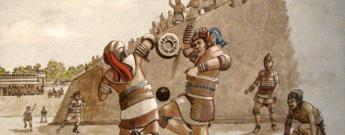
|
| Mexican Ball Court |
David Richards recently entertained and educated the Right Angle Club about his hobby interest in the Mexican ball game. Several thousand stadia have been excavated in Meso America, dating back three thousand years, so no other team sport can claim to have endured so long. The stadia vary in size from quite small (Copan) to quite large (Chichen Itza), the teams varied from two on a side to seven on a side, the rubber ball varied in size, and so on. But it has endured for many centuries as a team sport trying to get a rubber ball through hoops, on a playing field within a stadium. It had many fatal results, but it remains a little unclear whether these were player injuries or ritual human sacrifices.
The tour guides around these excavations are guilty of many fabrications for the enjoyment of gullible tourists but most of the real historical records were destroyed by the Spanish conquerors in their effort to eradicate idolatry. There were piles of skulls found rather near some ball stadia, so people were apparently killed there for some reason. A few wall glyphs depict some individuals being sacrificed by what seem to be priests. It seems possible the ball games were used to settle disputes, possibly wars, and in any event it looks as though many games were definitely played for keeps. Some players are depicted as holding clubs, so perhaps baseball can be traced back?
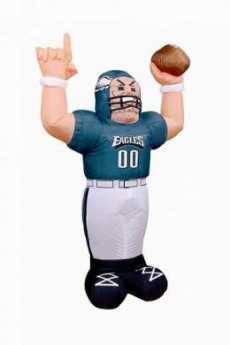
|
| Eagles with the ball |
The oldest stadia were constructed by the Olmecs, around Vera Cruz, about 1500 B.C. When the Spanish arrived, they found the ball stadium in Mexico City was the center of town and religious observance, so in typical Spanish reaction they built a cathedral on top of it. In this activity emerges the tradition that this particular ball court was regarded as sitting on top of the entrance to the underworld. Out of the various threads of fact and tradition, the general theory has emerged that the ball game in Aztec times had become a central ritual in the symbolism of life and death, of the transformation of human blood into maize, the transformative development of Mesoamerican culture.
That could not have been true throughout history, however. Ball courts have been found which were built for centuries before the Teotihuacan culture, and for centuries after that culture declined. During the Teotihuacan era of dominance, however, no ball courts. The religious association undoubtedly varied through that time, as well.
Central America had rubber trees, the rest of the world did not. The European invaders quickly took the six-pound rubber balls back with them, modified them and modified the rules. But all those different ball games do seem to trace back to this Mexican innovation. Human sacrifice is no longer an overt part of the experience, but team ball sports remain contact sports, with bloody consequences of some sort, no matter where they are played.
www.Philadelphia-Reflections.com/blog/1539.htm
Who Invented the Curve Ball?
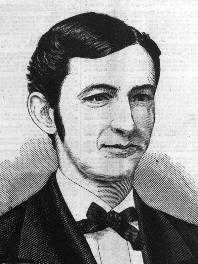
|
| Candy Cummings |
FOR many years, the argument raged as to whether the sudden change of direction of some pitched baseballs was a real movement or just an optical illusion. High-speed photography has apparently settled the question in favor of a real shift, caused by manipulating the spinning laces of the ball to get traction against the moving air. Controversy over which pitcher first discovered how to produce this effect intentionally has centered on the claims of William Arthur "Candy" Cummings of the Boston Excelsiors, and the competing claim of Fred Goldsmith of the Cincinnati Reds. Goldsmith later became the President of the National Association of Professional Baseball Players, which gave him a public relations advantage, and most historians give credit to Cummings. Both men died in 1924.
However, the 1916 minutes of the Medical Club of Philadelphia memorialize the death of Dr. Frederick P. Henry with the notation that it was he who invented the curved ball, while playing for the Princeton Nassaus. That's not exactly scientific proof, but the modesty of the claim makes you want to believe it may have been true.
Pets For all Seasons
People who have had a chance to talk with Queen Elizabeth report she is so fond of the Korgi dog pets that she scarcely talks about anything else. Perhaps because he is British, then, Professor James Serpell seems natural to have been elected chairman of a new department at the University of Pennsylvania Veterinary School, devoted to the study of Human-Animal Interactions. In any event, he made an interesting presentation to the Right Angle Club recently, reviewing the history of acquiring pets. A domesticated animal is not necessarily a pet; chickens and cows raised for food purposes are not considered real pets. A pet is domesticated purely for the purpose of companionship and love. Study of cave paintings and fossils seems to show that pets were maintained for many years before animals were domesticated for food purposes, although hunting dogs might have utility beyond providing love and companionship. The ancient nature of pets does seem to suggest purposes other than utility have been prized for a very long time, and not exclusively by people who are affluent.
Pets are steadily increasing in number, however, and are estimated as approaching 160 million, a number growing faster than the human population of the earth. The human residents of the earth are just about the only species known to make pets of other species, although monkeys will occasionally treat marmosets in a pet-like way. There might still be some utilitarian purposes in keeping pets, however; a goat companion is observed to have a calming effect on wild horses. For something whose utility is marginal, pets are a pretty expensive hobby. It is estimated that $45 billion is annually spent on them. A non-pet lover was once heard to remark that a cat is a domesticated parasite. Apparently, you either love pets or you don't.
It probably hasn't much to do with the motives of pet-lovers, but research does seem to show that those who maintain pets live longer than those who do not, whether the pet is a cat, dog, or rabbit. Pet owners have lower average blood pressure and score better on tests which reflect the prevailing stress level. In spite of snide remarks sometimes heard about people who love pets better than their neighbors, tests of interpersonal relationships actually seem to favor pet lovers.
In recent decades, there has been a growing tendency to confer rights, animal rights, on animals in general, and pets in particular. Remarkably, animal rights advocates seem to be more common in urban environments, than in rural ones. Perhaps the experience of wringing a chicken by the neck in order to prepare dinner hardens the heart. Next thing you know, the Tea Party phenomenon will start getting blamed on observations like this, so watch your language, please.
Reservoir on Reservoir Drive
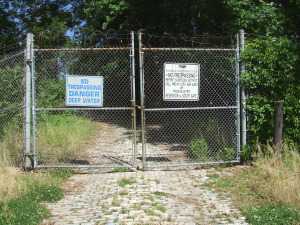
William Penn planned to put his mansion on top of Faire Mount, where the Art Museum now stands. By 1880, long after Penn decided to build Pennsbury Mansion elsewhere, city growth outran the capacity of the new reservoir system which had then been placed on Fairmount. An additional set of storage reservoirs were placed on another hill across East River (Kelly) Drive, behind Robert Morris' showplace mansion now called Lemon Hill (Morris merely called it The Hill); the area was eventually named the East Park Reservoir. In time, trees grew up along the ridge and houses got built; the existence of these reservoirs right in the city was easily forgotten, even though the towers of center city are now plainly visible from them. These particular reservoirs were never used for water purification; that's done in four other locations around town, and the purified water is piped underground to Lemon Hill, for last-minute storage; gravity pushes it through the city pipes as needed.
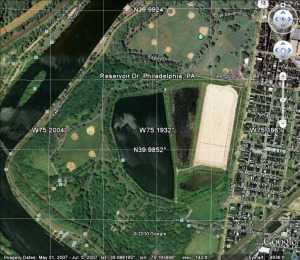
Now, here's the first surprise. Water use in Philadelphia has markedly declined in the past century. That's because the major water use was by heavy industry, not individual residences, so one outward sign of the switch from a 19th Century industrial economy to a service economy is -- empty old reservoirs. Only one-quarter of the reservoir capacity is in active use, protected by a rubber covering and fed by underground pipes. The rest of the sections of the reservoir are filled by rain and snow, but gradually silting up from the bottom, marshy at the edges. Unplanted trees have grown up in a jungle of second-growth, attracting vast numbers of migratory birds traveling down the Atlantic flyway. Although there are only a hundred acres of water surface here, the dense vegetation closes in around the visitor, giving the impression of limitless wilderness, except for the center city towers peeping through gaps in the forest. It's fenced in and quiet except for the birds. For a few lucky visitors, it's easy to get a feeling for how it must have looked to William Penn, three hundred or more years ago, and Robert Morris, two hundred years ago. In another sense, it demarcates the peak of Philadelphia's industrial age, from 1880 to 1940, because that kind of industrialization uses a lot of water.
The place, in May, is alive with Baltimore Orioles. Or at least their songs fill the air and experienced bird watchers know they are there. Even a beginner can recognize the red-winged blackbirds, flickers, robins, and wrens (they like to nest in lamp posts). The hawks nesting on the windowsills of Logan Circle suddenly makes a lot more sense, because that isn't very far away. In January, flocks of ducks and geese swoop in on the water surface, which by spillways is kept eight feet deep for their favorite food. Just how the fish got there is unclear, perhaps birds of some sort carried them in. The neighborhoods nearby are teeming with little boys who would love to catch those fish, but it's fenced and guarded much more vigorously since 9-11. In fact, you have to sign a formal document in order to be admitted; it says "Witnesseth" in big letters. Lawyers are well known for being timid souls, imagining hobgoblins behind every tree. However, there are some little reminders that evil isn't too far away. Just about once a week, someone shoots a gun into the air in the nearby city. It goes up and then comes down at random, with approximately the same downward velocity when it lands as when it left the muzzle upward. That is, it puts a hole in the rubber canopy over the active reservoir, which then has to be repaired. No doubt, if it hit your head it would leave the same hole. So, sign the document, and bring an umbrella if the odds worry you.
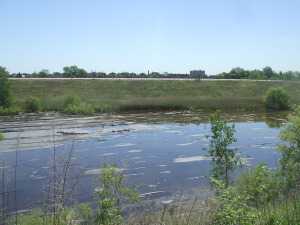
A treasure like this just isn't going to remain as it is, where it is. It's hard to know whether to be most fearful of bootleggers, apartment builders or city councilmen, but somebody is going to do something destructive to our unique treasure, possibly discovering oil shale beneath it for example, unless imaginative civil society takes charge. At present, the great white hope rests with a consortium of Outward Bound and Audubon Pennsylvania, who have an ingenious plan to put up education and administrative center right at the fence, where the city meets the wilderness. That should restrict public entrance to the nature preserve, but allow full views of its interior. Who knows, perhaps urban migration will bring about a rehabilitation of what was once a very elegant residential neighborhood. And push away some of those reckless shooters who now delight in potting at the overhead birds.
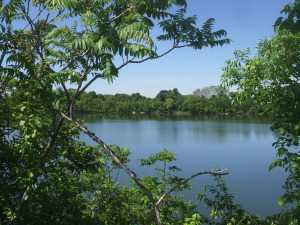
This whole topic of waterworks and reservoirs brings up what seems like a Wall Street mystery. Few people seem to grasp the idea, but Philadelphia is the very center of a very large industry of waterworks companies. The tale is told that the yellow fever epidemics around 1800 were the instigation for the first and finest municipal waterworks in the world. There's a very fine exhibit of this remarkable history in the old waterworks beside the Art Museum. But that's a municipal water service; why do we have private equity firms, water conglomerates, hedge funds for water industries, and other concentrations of distinctly private enterprise in the water? One hypothesis offered by a private equity partner was that the success of the municipal water works of Philadelphia stimulated many surrounding suburbs to do the same thing; it was surely better than digging your own well. This concentration of small and fairly inefficient waterworks around the suburban ring of this city might well have created an opportunity for conglomerates to amalgamate them at lower consumer cost. Anyway, it seems to be true that if you want to visit the headquarters of the largest waterworks company in the world, you go about seven miles from city hall and look around a nearby shopping center. If you are looking for the world's acknowledged expert in rivers, you go to the Academy of Natural Sciences of Philadelphia on Logan Square and look around for a lady who is 104 years old. And if you have a light you are trying to hide under a barrel, come to Philadelphia.
Conowingo
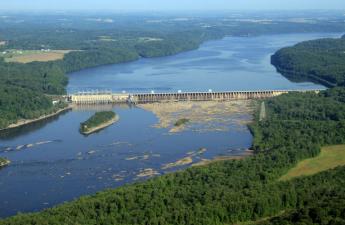
|
| Conowingo Dam |
IT was once a major hazard of travel between Philadelphia and Virginia, to cross the Susquehanna River along the way. The river is wide at the top of Chesapeake Bay, and the cliffs are high on both sides. Consequently, the cute little towns of Port Deposit and Havre de Grace grew up as places to stay in inns overnight, perhaps to throw a line into the water and catch your breakfast. Today, these little towns can be seen to have millions of dollars worth of cabin cruisers and sailboats at anchor, at least during certain seasons of the year. In 1928 the Conowingo Dam was built about ten miles north of the mouth of the river in order to harness the water power, and the Philadelphia Electric Company put a power station there as part of the dam, to generate electricity for Philadelphia. It doesn't seem so long ago, but it gave a mighty boost to the electrification of Philadelphia and its industries at the end of its industrial decline from 1900 to 1929. Unfortunately, competitive forms of power generation have now reduced the dam's output of electric power to periodic bursts during the day, and Philadelphia no longer enjoys a reliable cheap water-powered electricity advantage. Coal and nuclear came along, and now shale gas looks like the coming future.
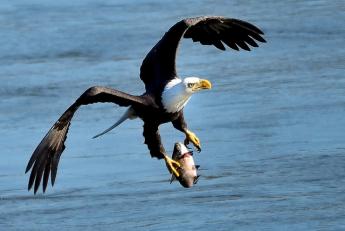
|
| Bald Eagle Fishing |
Although water power could be claimed to be not merely cheap but environmentally friendly, the unvarnished fact is fish get caught in the turbines and rather chewed up by being sucked from the tranquil lake on the upside, emerging at the bottom as a diced fresh fish salad. That attracts seagulls and other fish lovers to the base of the dam. Some fish escape the meat grinder and merely are stunned by the experience, floating downstream to be attractive to eagles, turkey vultures, hawks, and owls. The consequence is that many thousands of gulls sit on the downside of the dam, while hundreds of turkey vultures and eagles sit on the higher levels of the power generation apparatus. And hundreds of bird-watching nature lovers stand on the southern shore below the dam, poised with many thousands of dollars worth of camera equipment and binoculars. If you don't have a pair of binoculars, your visit there will certainly be substandard. Lots of fishermen are there, too, but depending on the waves of spawning fish at different seasons of the year; shad is particularly favored. You can now begin to see the prosperity of Port Deposit and Havre de Grace has a wider variety of attractiveness than merely sailboating and crabbing. There is, however, a large and ominous yellow warning sign.
The sign says you are standing on a riverbank where the water can suddenly rise without warning; if the red lights start blinking and the warning siren starts honking, immediately gather up your tripods and head for higher land. It looks pretty peaceful, however, and the people with tripods are mostly chatting happily with their friends. It can be pointed out, however, that about two hundred bald eagles are perched on the superstructures roundabout. Cameras are mostly digital these days, attached to the rear of a telescopic lens three feet long, and when they shoot bursts of exposures they sound like a machine gun. So, the bird photographers follow a swooping eagle eagerly, shooting away and hoping to catch the bird in an attractive pose, throwing away the rest of the pictures. Good shots are called "keepers", which the photographer is happy to show onlookers on the rear view screen of the camera/machine gun. More sedate bird watchers carry binoculars made in Germany or Switzerland, which cost thousands of dollars and produce really spectacular images. It's unclear whether all this expenditure is worth it, but there is little doubt in the bird lovers' minds you are wasting significant parts of the trip without some kind of binocular.
Suddenly, ye gods, the lights start to flash and the siren starts to honk loudly. Not knowing exactly what to expect, first-time visitors head for the hills. The old-timers with a Gatling gun on a tripod are much more casual, picking up their apparatus and scuttling several feet up the river bank. The birds seem to know what the signals mean, scramble into the air, or start to arrive from far perches. The electric company seems to have received a notice that more electric power generation is needed, so the gates at the bottom of the dam are lifted and water gushes forth; the water does indeed rise rather rapidly. The birds divide themselves into two groups: the gulls' circle in a thick spiral at the base of the dam, while the eagles and vultures circle independently in a second spiral, several hundred yards below the dam. One group looks for fish salad, and the other group prefers stunned whole fish. Photographers however much prefer the eagles downstream, circling and then swooping to the water's surface to grab a wiggling fish and running off with it. Some of the bigger bullies prefer to let others do the fishing, simply swooping to steal the fish. Ratta-tap-ratty tap goes the digitals. After twenty minutes it is all over, and the birds seem to realize it before the water stops gushing into geysers. The river recedes, birds go back to their perches, and quiet again rules the land.
On the way home, you notice something you perhaps should have known. Interstate 95 takes people speeding down the turnpike, just out of sight of the dam. You get there quicker, but don't see the sights. Coming back from the bird watching parking area which the electric company provides, you are more or less compelled to recognize that U.S. highway Number One goes right across the top of the dam, up to the hill and over the charming rolling countryside. Back to Philadelphia.
Our President Shows His Stuff
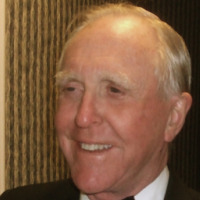
|
| President David Richards |
Three of our members recently flew to Argentina to play Rugby. That was Jack Nixon, John Wetzel, and our President, David Richards. We have all grown a little tired of being told that football is for sissies; Rugby, now that's a real man's sport. Down there, South of the Border, they really know how to play soccer, so Rugby is a natural for the Argentines. Well, eventually they came back, and we discover that our President was awarded a medal. John said it took him twenty years to win a medal, but Richards won it the first time he tried.

|
| Rugby |
Since he was at the microphone, President David had no choice but to tell us how it happened. It seems the new team had uniform pants which were a couple of inches shorter than his underwear, so in desperation, he decided to play without any underwear. At one moment crucial to the game, he was holding the ball, but the Argentine tackled him by grabbing the pants-top from behind. And so our hero was standing there pantless, holding the ball. So he was faced with an awful choice: either he must let down the team, or else run for the goal, dressed (or undressed) as he was.
So, of course, he ran for the goal. The bleachers went wild, cellphones clicked themselves silly, and our hero made the goal. And naturally, the Argentines respected excellence, so they gave him a medal.
| Posted by: SBF | May 22, 2006 10:53 AM |
19 Blogs
Mohammed Ali, Cassius Clay
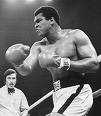 The greatest prizefighter of all time. Float like a butterfly, sting like a bee.
The greatest prizefighter of all time. Float like a butterfly, sting like a bee.
Paul Robeson 1898-1976
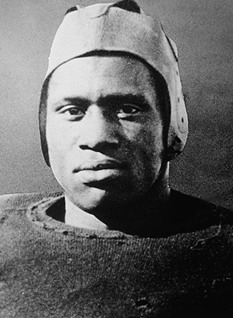 Valedictorian, All-American footballer, law degree, outstanding baritone, actor, film star, political activist -- Robeson rose to the top in the 1930s when by default he was always a pioneer. As a student, for example, he was the only black person on campus at Rutgers. His understandable resentments and show-biz surroundings propelled him into leftist activism. Mental infirmity and McCarthyism then brought him down.
Valedictorian, All-American footballer, law degree, outstanding baritone, actor, film star, political activist -- Robeson rose to the top in the 1930s when by default he was always a pioneer. As a student, for example, he was the only black person on campus at Rutgers. His understandable resentments and show-biz surroundings propelled him into leftist activism. Mental infirmity and McCarthyism then brought him down.
New Phillies Stadium
 Philadelphia builds professional sports stadia, like crazy.
Philadelphia builds professional sports stadia, like crazy.
Cricket Fanatics Say Baseball is for Sissies!
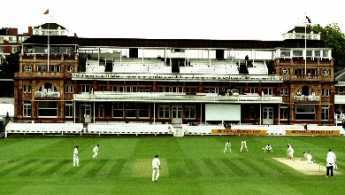 Cricket players may drink tea and eat watercress sandwiches, but they catch the batted ball with their bare hands, don't allow designated hitters, and keep playing one game for as long as five days. So, who's a sissy?
Cricket players may drink tea and eat watercress sandwiches, but they catch the batted ball with their bare hands, don't allow designated hitters, and keep playing one game for as long as five days. So, who's a sissy?
Rugby in Our Midst
 Englishmen play cricket and rugby. Americans play baseball and football. The rest of the world plays soccer and calls it football.
Englishmen play cricket and rugby. Americans play baseball and football. The rest of the world plays soccer and calls it football.
Yet Another Toast to Dr. J. William White
 a great many toasts to J. William White have been given since his death in 1916. This one was proposed by Philadelphia's lawyer-novelist Arthur R. G. Solmssen.
a great many toasts to J. William White have been given since his death in 1916. This one was proposed by Philadelphia's lawyer-novelist Arthur R. G. Solmssen.
Forty Days Before the Mast
 Before steamships, most of our ancestors spent a month at sea in a sailing ship and never would consider going back home if it meant another such trip. Here's a taste of what it was like.
Before steamships, most of our ancestors spent a month at sea in a sailing ship and never would consider going back home if it meant another such trip. Here's a taste of what it was like.
Dog Days
 Hunting rabbits with a pack of French hounds scarcely sound like a matter to agitate the Pennsylvania Legislature and its Governor, so maybe something else is afoot.
Hunting rabbits with a pack of French hounds scarcely sound like a matter to agitate the Pennsylvania Legislature and its Governor, so maybe something else is afoot.
Camden Riversharks
 Camden NJ has a minor league baseball team which in some ways is more fun than the Major leagues. Fans certainly sit closer to the players.
Camden NJ has a minor league baseball team which in some ways is more fun than the Major leagues. Fans certainly sit closer to the players.
Lawn Tennis at the Cricket Club
 Lawn tennis is slightly older than tennis on clay courts, but it's harder to maintain grass than other surfaces, so it's less common.
Lawn tennis is slightly older than tennis on clay courts, but it's harder to maintain grass than other surfaces, so it's less common.
Shad
 The rivers once teemed with these big fish every springtime. They are making a hesitant comeback.
The rivers once teemed with these big fish every springtime. They are making a hesitant comeback.
Skating and Humane
 America's premier indoor skating club had its origin as a life-saving association.
America's premier indoor skating club had its origin as a life-saving association.
SCUBA Tours of the Andrea Doria
 The Stockholm collided with the Andrea Doria and sank her in 1956 in 250 feet of water. Lots of weekend visitors still wander around inside the ship.
The Stockholm collided with the Andrea Doria and sank her in 1956 in 250 feet of water. Lots of weekend visitors still wander around inside the ship.
Mesoamerican Ball Game
 The team ball game was apparently invented by Olmecs about 3000 years ago. Soccer, football and maybe baseball are variants.
The team ball game was apparently invented by Olmecs about 3000 years ago. Soccer, football and maybe baseball are variants.
Who Invented the Curve Ball?
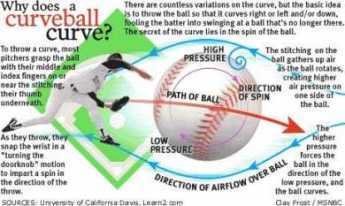 Inside baseball is full of statistics. In the case of the invention of the curve ball, prevailing traditions have been challenged.
Inside baseball is full of statistics. In the case of the invention of the curve ball, prevailing traditions have been challenged.
Pets For all Seasons
 Penn's Veterinary School has established a department for the study of pets and pet loving.
Penn's Veterinary School has established a department for the study of pets and pet loving.
Reservoir on Reservoir Drive

Conowingo
 After ancient disputes between William Penn and Lord Baltimore, the mouth of the Susquehanna into the Chesapeake Bay is located in Maryland. However, the Philadelphia Electric Company got its power from the Conowingo Dam, and Philadelphia bird watchers by the hundreds go there to watch thousands of birds, attracted by millions of fish. But when the buzzers sound and the red lights flash, run for higher ground.
After ancient disputes between William Penn and Lord Baltimore, the mouth of the Susquehanna into the Chesapeake Bay is located in Maryland. However, the Philadelphia Electric Company got its power from the Conowingo Dam, and Philadelphia bird watchers by the hundreds go there to watch thousands of birds, attracted by millions of fish. But when the buzzers sound and the red lights flash, run for higher ground.
Our President Shows His Stuff
 David Richards goes all out.
David Richards goes all out.